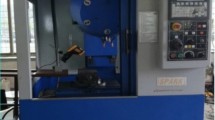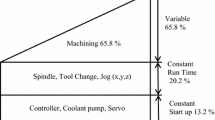Abstract
There are many advanced tooling approaches in metal cutting to enhance the cutting tool performance for machining hard-to-cut materials. The self propelled rotary tool (SPRT) is one of the novel approaches to improve the cutting tool performance by providing cutting edge in the form of a disk, which rotates about its principal axis and provides a rest period for the cutting edge to cool and allow engaging a fresh cutting edge with the work piece. This paper aimed to present the cutting performance of SPRT while turning hardened EN24 steel and optimize the machining conditions. Surface roughness (R a) and metal removal rate (r MMR) are considered as machining performance parameters to evaluate, while the horizontal inclination angle of the SPRT, depth of cut, feed rate and spindle speed are considered as process variables. Initially, design of experiments (DOEs) is employed to minimize the number of experiments. For each set of chosen process variables, the machining experiments are conducted on computer numerical control (CNC) lathe to measure the machining responses. Then, the response surface methodology (RSM) is used to establish quantitative relationships for the output responses in terms of the input variables. Analysis of variance (ANOVA) is used to check the adequacy of the model. The influence of input variables on the output responses is also determined. Consequently, these models are formulated as a multi-response optimization problem to minimize the R a and maximize the r MMR simultaneously. Non-dominated sorting genetic algorithm-II (NSGA-II) is used to derive the set of Pareto-optimal solutions. The optimal results obtained through the proposed methodology are also compared with the results of validation experimental runs and good correlation is found between them.














Similar content being viewed by others
References
Kishay HA, Wilcox J (2003) Tool wear and chip formation during hard turning with self propelled rotary tools. Int J Mach Tools Manuf 43(4):433–439
Dessoly V, Melkote SN, Lescalier C (2004) Modeling and verification of cutting tool temperatures in rotary turning of hardened steel. Int J Mach Tools Manuf 44:1463–1470
Armarego EJA, Karri V, Smith AJR (1994) Fundamental studies of driven and self-propelled rotary tool cutting processes—I. Theor Investig Int J Mach Tools Manuf 34(6):785–801
Venuvinod PK, Lau WS, Narasimha RP (1981) Some investigations into machining with driven rotary tools. J Eng Ind 103:469–477
Lei ST, Liu WJ (2002) High-speed machining of titanium alloys using the driven rotary tool. Int J Mach Tools Manuf 42:653–661
Li L, Kishawy HA (2006) A model for cutting forces generated during machining with self-propelled rotary tools. Int J Mach Tools Manuf 46(12):1388–1394
Kishawy HA, Pang L, Balazinski M (2011) Modeling of tool wear during hard turning with self-propelled rotary tools. Int J Mech Sci 53(11):1015–1021
Joshi SS, Ramakrishnan N, Nagarwalla HE, Ramakrishnan P (1999) Wear of rotary carbide tools in machining of Al/SiCp composites. Wear 230:124–132
Ezugwu EO (2007) Improvements in the machining of aero-engine alloys using self-propelled rotary tooling technique. J Mater Process Technol 185:60–71
Wang SH, Zhu X, Li X, Turyagyenda G (2006) Prediction of cutting force for self-propelled rotary tool using artificial neural networks. J Mater Process Technol 180:23–29
Box GEP, Wilson KB (1951) On the experimental attainment of optimum conditions (with discussion). J R Stat Soc Ser B 13(1):1–45
Kilickap E, Huseyinoglu M, Yardimeden A (2011) Optimization of drilling parameters on surface roughness in drilling of AISI 1045 using response surface methodology and genetic algorithm. Int J Adv Manuf Technol 52:79–88
Palanikumar K (2007) Modeling and analysis for surface roughness in machining glass fibre reinforced plastics using response surface methodology. Mater Des 28:2611–2618
Palanikumar K, Latha B, Senthilkumar VS, Karthikeyan R (2009) Multiple performance optimization in machining of GFRP composites by a PCD tools using non dominated sorting genetic algorithm (NSGA-II). Met Mater Int 15(2):249–258
Kansal HK, Singh S, Kumar P (2005) Parametric optimization of powder mixed electrical discharge machining by response surface methodology. Int J Mater Process Technol 169:427–436
Sahin Y, Motorcu AR (2005) Surface roughness model for machining mild steel. Mater Des 26(4):321–326
Ghafari S, Aziz HA, Isa MH, Zinatizadeh AA (2009) Application of response surface methodology (RSM) to optimize coagulation–flocculation treatment of leachate using poly-aluminum chloride (PAC) and alum. J Hazard Mater 163:650–656
Kalyanmoy D, Amrit P, Sameer A, Meyarivan T (2002) A fast and elitist multi-objective genetic algorithm : NSGA-II. IEEE Trans Evolut Comput 6(2):182–197
Montgomery DC (2001) Design and analysis of experiments. Wiley, Hoboken
Stat-Ease Inc (2001) Design-expert software, educational version 6.0.9 for windows. Wiley, New York
Author information
Authors and Affiliations
Corresponding author
Rights and permissions
About this article
Cite this article
Rao, T.B., Krishna, A.G., Katta, R.K. et al. Modeling and multi-response optimization of machining performance while turning hardened steel with self-propelled rotary tool. Adv. Manuf. 3, 84–95 (2015). https://doi.org/10.1007/s40436-014-0092-z
Received:
Accepted:
Published:
Issue Date:
DOI: https://doi.org/10.1007/s40436-014-0092-z




